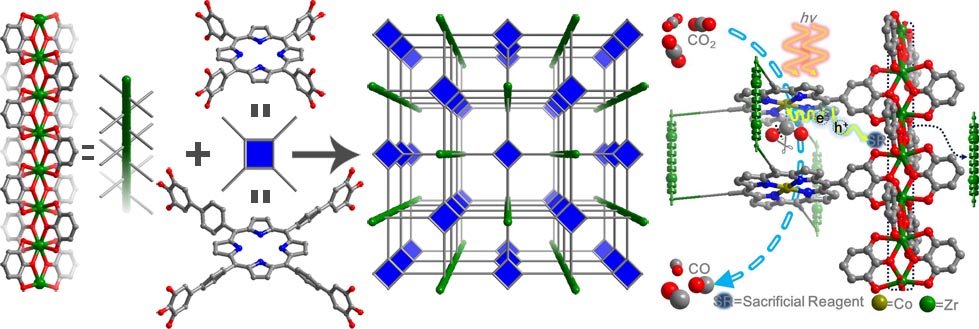It is well known that zirconium (Zr) MOFs are the most stable of all MOFs. Can we make the best even better? Even if we can, what new applications would be opened up with more stable Zr-MOFs?
In a study published in Adv. Mater., the research groups led by Prof. LIN Qipu and ZHANG Jian from Fujian Institute of Research on the Structure of Matter (FJIRSM) of the Chinese Academy of Sciences (CAS) reported a family of tetragonal Zr-polyphenolate-porphyrin frameworks (ZrPP-n, n = 1, 2) that are initially computationally designed and then subsequently synthesized. Among these materials, ZrPP-1 reveals the largest range of pH resistance among all MOFs, retaining its framework integrity against the attack of HCl (pH = 1) and even the saturated NaOH solution (ca. 20 M).
Another important aspect of this study is that highly stable Zr-oxide chains could be coupled with light-harvesting porphyrinic units, as well as catalytically active metal centers, in one uniformly integrated heterometallic crystalline material. As a result of this potent design strategy, the material of ZrPP-1 exhibits not only high CO2 trapping capability (ca. 90 cm3·g-1 at 1 atm, 273 K), but also high photocatalytic activity for reduction of CO2 into CO (ca. 14 μmol·g-1h-1) and the highest selectivity for CO over CH4 (>96%) under visible-light irradiation (λ > 420 nm).
It is noteworthy that ZrPP-1 has the strong chemical resistance in extreme alkali conditions, which is particularly advantageous for reactions that require harsh conditions. Such advantages have been demonstrated by showing these catalysts can be recycled multiple times without appreciable loss of activity in this study.
The structures of ZrPP-n’s and their photoreduction CO2-to-CO schematic diagram under visible light irradiation (Image by Prof. LIN’s Group)

The structures of ZrPP-n and their photoreduction CO2-to-CO process under visible light irradiation (Image by Prof. LIN’s Group)
Contact:
Prof. LIN Qipu
Fujian Institute of Research on the Structure of Matter
Chinese Academy of Sciences
Email: linqipu@fjirsm.ac.cn